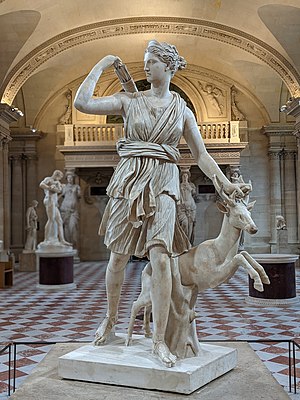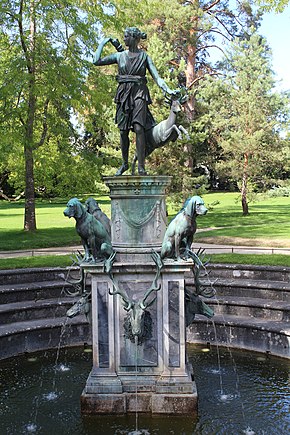Diana of Versailles

TheDiana of VersaillesorArtemis, Goddess of the Hunt(French:Artémis, déesse de la chasse) is a slightly over-lifesize[1]marble statue of the Roman goddessDiana(Greek: Artemis)with a deer. It is currently located in theMusée du Louvre,Paris.[2]The statue is also known asDiana with a Doe(French:Diane à la biche),Diana Huntress(French:Diane chasseresse), andDiana of Ephesus.It is a partially restored Roman copy (1st or 2nd century AD) of a lost Greek bronze original attributed toLeochares,c. 325 BC.[3][4]
Description
[edit]Diana is represented at the hunt, hastening forward, as if in pursuit of game. She looks toward the right and with raised right arm is about to draw an arrow from herquiver.Her left arm has been restored, and a deer has been added at her feet, although one might have expected a dog.[5]Her left hand is holding a small cylindrical fragment, which may be part of what was once abow.She wears a shortDorianchiton,ahimationaround her waist, andsandals.Her second toes are longer than her big toes, a condition known asMorton's toe.[6]
History
[edit]The statue was given byPope Paul IVtoHenry II of Francein 1556[7]with a subtle but inescapable allusion to the king's mistress,Diane de Poitiers.It was probably discovered in Italy. One source suggests theTemple of Diana (Nemi),an ancient sanctuary;[8]another positsHadrian's VillaatTibur.[9]
"Alone amongst the statues exported from Italy before the second half of the seventeenth century theDiane Chasseresseacquired a reputation outside Italy equivalent to the masterpieces in theBelvedereor theVilla Borghese",[10]though its admirers generally confused it with theArtemisat thetemple of Ephesus.[11]It was installed as the central feature of the Jardin de la Reine (today's Jardin de Diane) laid out west of the Galerie des Cerfs at theChâteau de Fontainebleau;there it was the most prominently displayed and among the first Roman sculptures to be seen in France.
In 1602,Henri IVremoved it to thePalais du Louvre,where theDianawas installed in a gallery specially designed to receive it, the Salle des Antiques (now theSalle des Caryatides). At the time, its restorations were revised byBarthélemy Prieur.In 1696 it was installed in the Grande Galerie (Hall of Mirrors) ofVersaillesbyLouis XIV.[12]As one of France's greatest treasures, theDiane Chasseressereturned to the Louvre inAn VI(1798) of theFrench Republican calendar(Haskell and Penny 1981:196).[13][14]It was restored once more, in 1802, by Bernard Lange.[15]
Fountain of Diana at Fontainebleau
[edit]
In 1605, after the marble Roman statue had been removed from Fontainebleau, Barthélemy Prieur cast a replacement, a bronze replica which was set upon a highManneristmarble pedestal, part of a fountain arranged by the hydraulics engineerTommaso Franciniin 1603. The fountain incorporated bronze hunting dogs and stag's heads spitting water, sculpted byPierre Biard,and was located in the Jardin de la Reine, with aparterresurrounded by anorangery.[16][17]
At the time of theFrench Revolution,Prieur's bronze was sent to the Louvre, but in 1813,Emperor Napoleonoffered it toEmpress Joséphineto decorate herChâteau de Malmaison.At the same time, he ordered the present bronze, a replica cast by the Keller brothers in 1684 and formerly at theChâteau de Marly(demolished 1806), be placed on the fountain at Fontainebleau. Prieur's bronze was later returned to the Louvre and only in the 20th century was it brought back to Fontainebleau, where it was placed in the Galerie des Cerfs.[17]
Other replicas
[edit]Comparable Roman replicas of the same model, noted by the Louvre's website, have been found atLeptis Magna(Libya), atAntalya(Turkey) and alsoAnnaba(Algeria).[citation needed]
Besides the modern era replicas by Prieur and the Keller brothers, a full-size bronze replica was made in 1634 byHubert Le SueurforCharles I of England,the brother-in-law ofLouis XIII.[18]ForMarly,a marble copy was executed byGuillaume Coustouin 1710. In the second half of the 18th century, numerous replicas of all sizes were created in bronze, plaster, and lead (Haskell and Penny 1981:197).
A miniature replica of the statue stood on the fireplace mantle in theTitanic'sfirst class lounge. In 1986,Robert Ballarddiscovered and photographed the statue on the sea floor near the bow section of the wreck.[citation needed]
See also
[edit]- Fountain of Dianafrom the Château d'Anet
Notes
[edit]- ^The statue stands 2.01 meters in height.
- ^Diane de Versailles(in French), Louvre, 125,retrieved2023-07-15
- ^I. Leventi,"Leochares",vol. 19, pp. 169–170, inThe Dictionary of Art,34 volumes, edited by Jane Turner. New York: Grove.ISBN9781884446009.
- ^"Artemis with a Doe", The Louvre Museum. Archived 2 November 2020.
- ^Anonymous 1996, p. 90.
- ^"The Story Behind the" Greek Foot "and its Medical Explanation".Greek Reporter.
- ^"Diane à la biche",Château de Fontainebleau,Archive copy (22 April 2021);Musée du Louvre on-line catalogue, archived 18 August 2018.The archived copy at the Fontainebleau website cites a 1968 manuscript by Boris Lossky, intended for theBulletin de la Société de l’Histoire de l’art Français.Other sources (Haskell and Penny 1981, p. 196; Anonymous 1996, p. 90) give 1586 as the earliest certain date the statue is known to have been at Fontainebleau (mentioned by the Dutch travellerVan Buchell[Haskell and Penny]) and was reported in the 17th century to have come from theChâteau de Meudon.
- ^Richard Cooper (2016).Roman Antiquities in Renaissance France, 1515–65,p. 189.Routledge.ISBN9781317061861.
- ^"Choice examples of Classic sculpture:Diana,after p. 274 inAlexis de Tocqueville,Democracy in America,translated by Henry Reeve, revised edition, vol. 1. New York: The Colonial Press, 1900.
- ^Haskell and Penny, 1981, p. 196.
- ^The error was forcefully refuted byJean-Aymar Piganiol de La Force,Nouvelle description des châteaux et des parcs de Versailles et de Marly(Paris, 1713), Haskell and Penny note (1981:196).
- ^Date according to theMusée du Louvre on-line catalogue.
- ^Accession number 589.
- ^Anonymous 1996, p. 90: "Numerous copies of the statue from the seventeenth, eighteenth, and nineteenth centuries attest to its popularity during that era, but the work is widely ignored today."
- ^Lange is also credited with the first restorations to theVenus de Milo
- ^The orangery was swept away underLouis-Philippe.
- ^ab"Diane à la biche",Archive copy (22 April 2021),Château de Fontainebleau; Jean-Marie Pérouse de Montclos,Le château de Fontainebleau(Paris: Scala, 2009), p. 212.
- ^It is now atWindsor Castle.
References
[edit]- Anonymous (1996)."Artemis of Versailles (Diane Chasseresse), p. 90,inEncyclopedia of the History of Classical Archaeology,edited by Nancy Thomson de Grummond. Routledge. Digital reprint 2015:ISBN9781134268542.
- Collignon, Maxime (1890).Manual of Mythology, in Relation to Greek Art.H. Grevel & Co.. Page 94.
- Haskell, Francis;Nicholas Penny (1981).Taste and the Antique: The Lure of Classical Sculpture 1500–1900.Yale University Press. Cat. no. 30.
- Robertson, Martin (1975).A History of Greek Art.Cambridge University Press. Vol. I, pp. 460–461.
